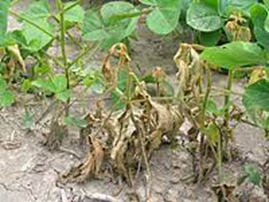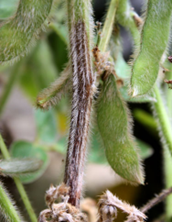Be on the lookout: Phytophthora Root Rot and Stem Rot
July 2, 2024
Has your season had more rain than you needed?
Even with all the rain, have your soybeans started to look drought-stressed? That is not drought, obviously. However, that appearance means you may have Phytophthora Root Rot and Stem Rot, especially if you have heavier, poorly drained soils or you have had heavy rainfall this year. These pathogens can survive in the soil for several years. Phytophthora needs free water and moderate soil temperatures for the spores to root. Phytophthora enters through the roots and moves up the stem.
Diseased plants will start to appear in low lying, waterlogged areas. Phytophthora can occur at any growth stage in soybeans, but symptoms will begin to show up in July and become more evident when the soils dry out.

What to look for to reduce the impact of Phytophthora root rot or stem rot in the future?
While each soybean variety may vary in its tolerance to this disease, you should look for dark brown or purple lesions on the stem starting at the soil line. In your fields, there will be clusters of plants with the disease but not every plant with show symptoms. When the leaves die, they will remain attached.
DF Seeds includes a fungicide (Metalaxyl/Mefenoxam) in our seed treatment to prevent Phytophthora in seedlings. As the soybeans grow, the race-specific resistance (RPS) will help prevent this disease as the soybeans grow. The RPS is listed in our seed guide. The most common RPS are 1k and 1c. We have also introduced 3a. Some of our varieties have strong natural field tolerance without a specific race resistance as well.
As always, your DF Seeds dealer or DSM are happy to help diagnose this disease or to help guide you to a variety to protect against this issue in the future.


